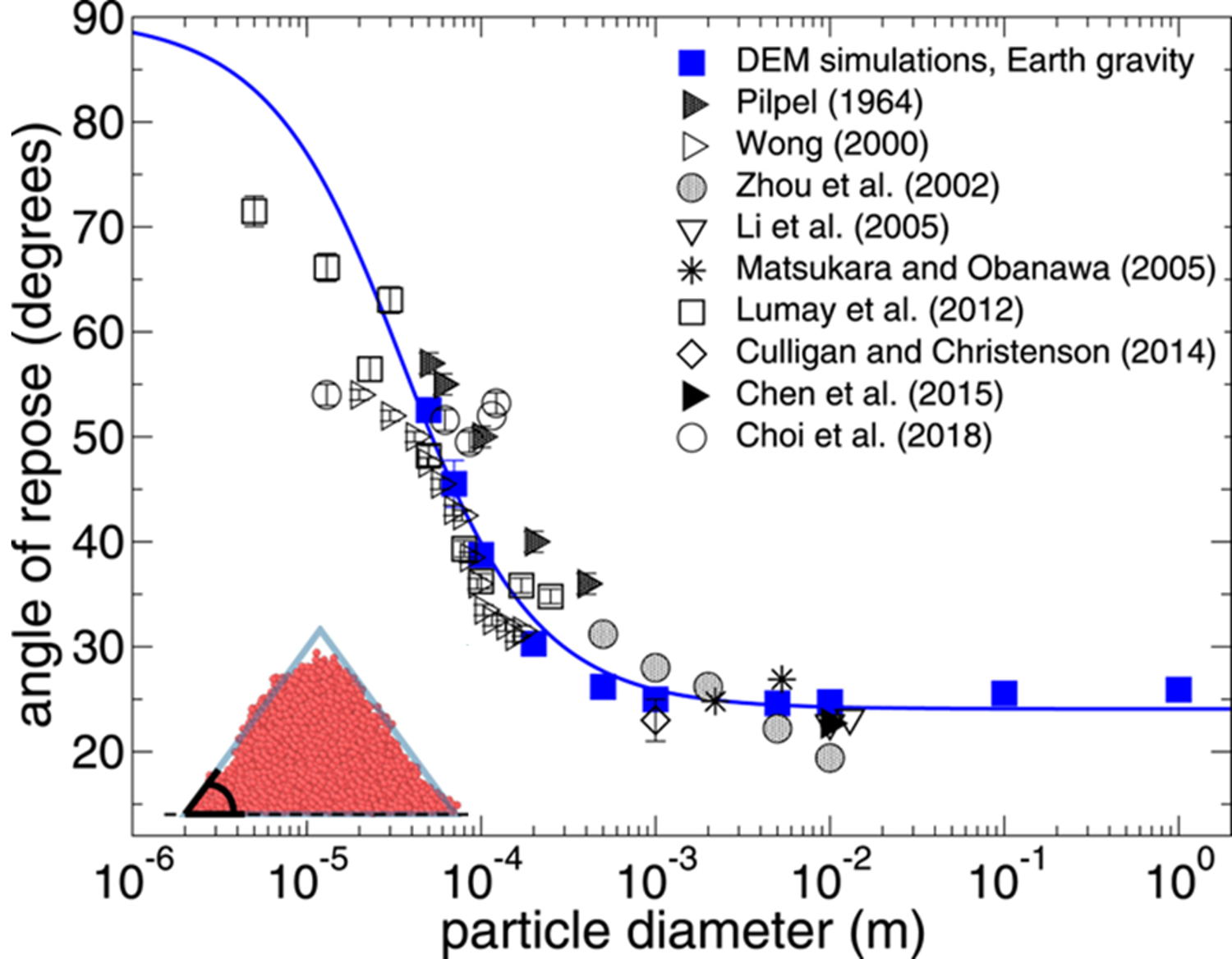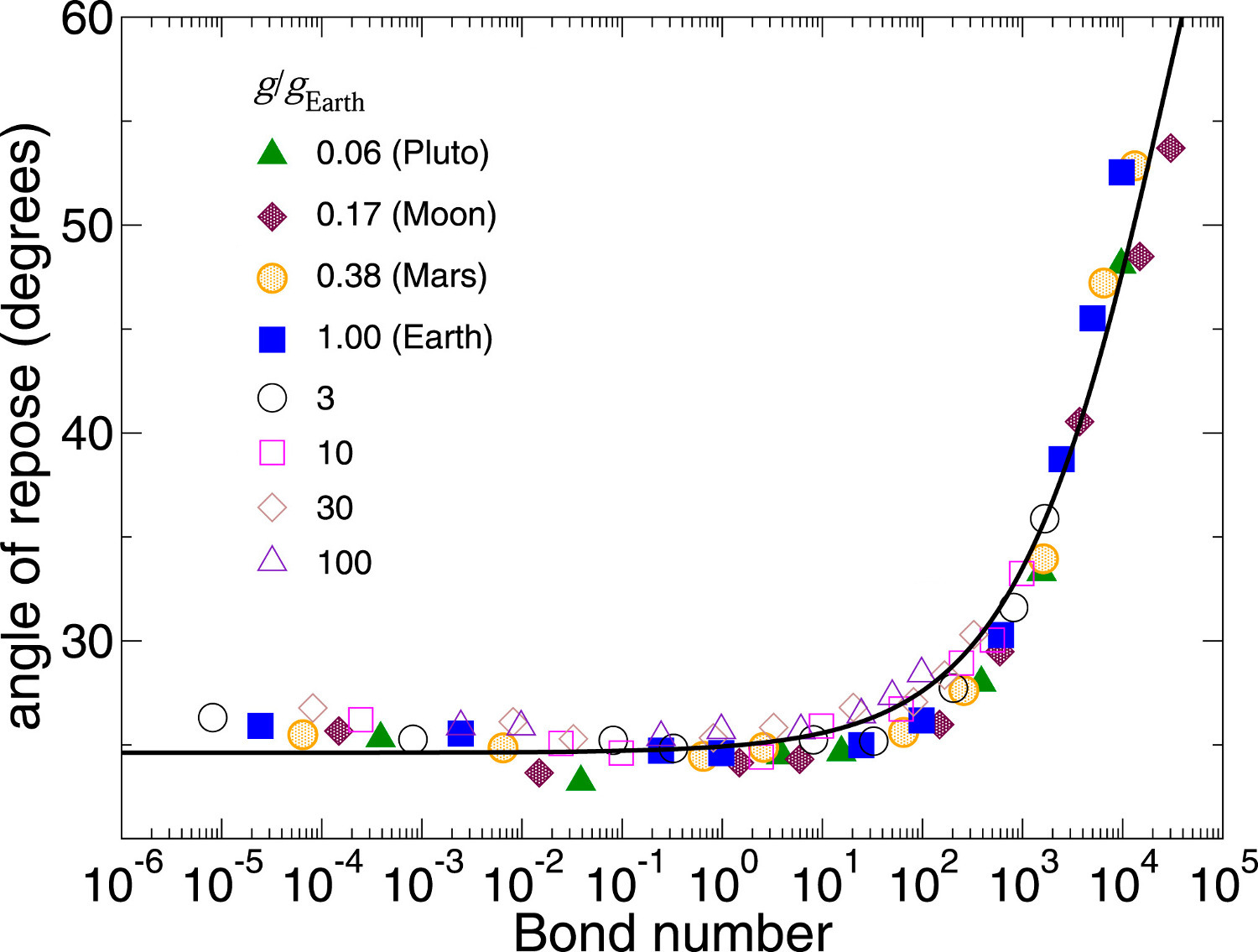A model for the angle of repose of granular matter in extra-terrestrial environments
- 1Faculty of Physics, University of Duisburg-Essen, Duisburg, Germany (eric.parteli@uni-due.de)
- 2Institute of Geophysics and Meteorology, University of Cologne, Cologne, Germany
Abstract
One of the most important observables to characterize the packing behaviour and flowability of sand, dust and regolith over the terrestrial bodies of our Solar System is their granular angle of repose — the angle that the sloping side of a heap of particles makes with the horizontal. This angle depends, for instance, on particle size, because the smaller the grain diameter is, the more significant attractive forces between atoms and molecules on the surface of the grains be- come relative to particle weight. However, the dependence of the angle of repose on particle size and gravity has remained elusive. Here we elucidate this dependence by means of direct (particle-based) numerical simulations of granular heaps. We obtain a simple mathematical expression that reproduces a comprehensive set of experimental observations on the angle of repose as a function of particle size, as well as results from our simulations under gravity values from 0.06 to 100 times Earth’s gravity. Our model could find, thus, application to infer on particle size from extra-terrestrial granular slopes, for instance of impact craters and extra-terrestrial dunes. Moreover, our model suggests that the angle of repose on Mars or Pluto may be studied experimentally without any need of adjusting gravity, and by tuning, instead, particle size according to our mathematical expression.
Numerical Experiments
We investigate the particle dynamics using the Discrete-Element-Method [1], which consists of solving Newton’s equations for all particles in the system. We consider contact forces, sliding and rolling friction, as well as non-bonded attractive particle interaction (van der Waals) forces. Our reproduces the packing fraction and packing structure of fine polydisperse powders of different materials [2, 3]. Here we assume spherical SiO2 particles owing the broad range of experimental data available for validation.
To form the heaps, we pour the particles onto a frictional square horizontal plate of sides 40 d. The particles are inserted within a square cross-section of side length 4.4 d, which is cocentric with and extends from a height of 20 − 30 d above the plate. We pour in total 25, 000 particles and apply open boundaries (no vertical walls). Therefore, some particles abandon the simulation domain through its lateral borders and are not replaced by new ones. The final heaps are contain between 5, 000 and 14, 000 particles.
Results and Discussion
First we elucidate the dependence on the particle size by considering terrestrial gravity (Fig. 1). We find that our simulation results can be fitted well by the equation [4]
θ = tan-1[μ · (1+D/d)] (1),
with the effective friction coefficience μ≈0.45 and the characteristic length-scale D≈87 µm. We find that the term D/d encodes the effect of attractive van der Waals forces. Indeed, our results from numerical simulations without these forces can be described by the model θ = tan-1[μ] [4].
Next, we vary the gravity level g̃ ≡ g/gEarth from 0.06 to 100. We find that Eq. (1) fits our simulation results well over this entire broad range of g̃, provided D is adjusted according to D ≈ DE ·g̃-1/2, where DE = 87 μm is the terrestrial value for D in Eq. (1). Therefore, if, for a granular material of given type, the values of DE and μ are known (by fitting Eq. (1) to experiments on Earth), then, with our model, it is possible to estimate the particle-size-dependence of the angle of repose for this material under extra-terrestrial gravity. Our model is consistent with experimental observations in the Bremer drop tower and in parabolic flights, that granular materials behave more cohesively under lower gravity [5, 6]. For instance, we find that dry sand-sized (∼ 200 μm) SiO2 particles on Pluto would have angle of repose comparable to powdered sugar particles (∼ 50 μm) on Earth. Moreover, due to the scaling of van der Waals forces and particle weight with d and d-3g-1, respectively, Eq. (1) leads to
θ = tan-1[μ · (1+ β · Bo1/2)] (2),
where Bo is the Bond number, i.e., the ratio of attractive interaction forces to particle weight, and β ≈0.014. Figure 2 shows that Eq. (2) describes very well the results from our numerical simulations for all values of gravity. Currently, we are modelling the angle of repose with other types of particle-particle interactions. We also find that particle shape exert a crucial role and is indispensable to understand, for instance, the angles of repose of sand dunes on Earth and Mars.
Acknowledgements
We thank the German Research Foundation (DFG) for funding through the Heisenberg Programme and grant 348617785.
References
[1] Cundall, P. A. and Strack, O. D. L. A discrete numerical model for granular assemblies. Geotechnique 29, 47-65 (1979).
[2] Parteli, E. J. R., Schmidt, J., Blümel, C., Wirth, K.-E., Peukert, W. and Pöschel, T. Attractive particle interaction forces and packing density of fine glass powders. Scientific Reports 4, 6227 (2014).
[3] Schmidt, J., Parteli, E. J. R., Uhlmann, N., Wörlein, N., Wirth, K.-E., Pöschel, T. and Peukert, W. Packings of micron-sized spherical particles ? insights from bulk density determination, x-ray microtomography and discrete element simulations. Advanced Powder Technology, 31:2293?2304 (2020).
[4] Elekes, F. and Parteli, E. J. R. An expression for the angle of repose of dry cohesive granular materials on Earth and in planetary environments. Proceedings of the National Academy of Sciences of the USA, 118, e2107965118 (2021).
[5] Hofmeister, P. G., Blum, J. and Heisselmann, D. Flows of dense granular media. Annual Review of Fluid Mechanics 40, 1-24 (2008).
[6] Kleinhans, M. G., Markies, H., de Vet, S. J., in’t Veld, A. C. and Postema, F. N. Static and dynamic angles of repose in loose granular materials under reduced gravity. Journal of Geophysical Research 116, E11004 (2011).

Figure 1: Angle of repose under Earth’s gravity [4]: Blue squares denote our simulation results, the other symbols denote experimental observations, while the continuous line is the best fit using Eq. (1).

Figure 2: Angle of respose as a function of the Bond number, which scales with 1/(d2 g) [4]: Symbols denote our simulation results, the continuous line denotes the best fit using Eq. (2).
How to cite: Parteli, E. and Elekes, F.: A model for the angle of repose of granular matter in extra-terrestrial environments, Europlanet Science Congress 2024, Berlin, Germany, 8–13 Sep 2024, EPSC2024-643, https://doi.org/10.5194/epsc2024-643, 2024.